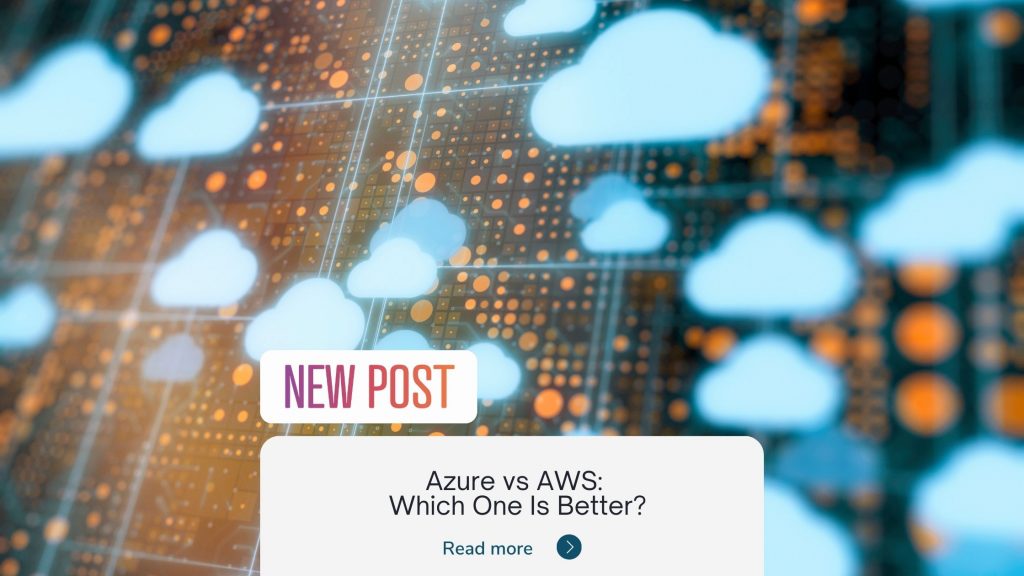Looking for a cloud computing platform but not sure which one is right for you? Check out our comparison of Azure vs AWS to see which one is better suited for your needs.
Introduction
Cloud computing has drastically changed the way businesses operate in today’s day and age. With more and more things going digital, there is a greater need for businesses to move to the cloud in order to keep up with the competition.
When it comes to cloud computing, there are a lot of different options available and it can be tough for enterprises to select the best possible one for their needs. Azure and AWS are two of the most prominent names in cloud computing. In recent years, the demand for Azure and AWS certifications has increased significantly. If you’ve been confused about which one to choose, we’re here to help.
Table of Content
- What is Cloud Computing?
- Different types of Cloud Computing
- Understanding AWS & Azure
- Azure vs AWS: Advantages
- Azure vs AWS: Disadvantages
- Azure vs AWS: Key Differences
What is Cloud Computing?
Cloud computing is a model for enabling ubiquitous, convenient, on-demand network access to a shared pool of configurable computing resources (e.g., networks, servers, storage, applications, and services) that can be rapidly provisioned and released with minimal management effort or service provider interaction. Two fundamental characteristics of cloud computing are “on-demand self-service” and “broad network access.”
Cloud computing helps companies achieve the following:
1) Lower costs: Installing and managing on-premises infrastructure can prove to be expensive. With the cloud, companies don’t have to invest in on-premises infrastructure.
2) Agility: Cloud lets companies start using applications within minutes instead of waiting for IT to respond to requests or purchase the hardware required.
3) Scale: Cloud gives companies the flexibility to scale the capacity up or down according to their needs.
Different types of Cloud Computing
There are three types of cloud computing: Public cloud, Private cloud, and Hybrid cloud. Let’s discuss them in detail.
Public Cloud :With a public cloud, you can access your computing resources through the internet. You can use these resources for free or on a subscription basis. The public Cloud Service Providers own and manage all of the data centers and infrastructure.
Private Cloud: A private cloud is a cloud infrastructure that is accessible only by a single customer. It can be hosted on-premises or in a remote data center. Companies sometimes prefer the private cloud because it helps them to securely deal with sensitive data.
Hybrid Cloud: Hybrid cloud is the perfect solution for companies who want the best of both worlds when it comes to their infrastructure. With a hybrid cloud, businesses get the flexibility to choose which applications run in a private or public cloud environment. This provides businesses with a more customized approach to their infrastructure needs, and the ability to change things up as their needs evolve.
Want to learn more about Cloud Computing? Check out our Cloud Computing courses!
Understanding AWS & Azure
Let’s learn about Azure or Microsoft Azure & AWS before we understand their advantages & disadvantages.
Microsoft Azure: Azure is Microsoft’s cloud computing service, developed in the .NET framework. It allows users to create, deploy and manage applications on a global network of Microsoft-managed data centers. It offers a variety of services like storage, networking solutions, developer tools, etc.
Azure offers services in three different categories – software as a service (SaaS), platform as a service (PaaS), and infrastructure as a service (IaaS). Azure was built to offer the same functionality of Amazon Web Services (AWS) but with a focus on enterprise customers. Azure is a great option for businesses looking to expand their offerings but don’t want to risk their data on a third-party platform.
AWS: AWS is the abbreviation for Amazon Web Services. It is a collection of remote computing services, also called web services, to help you build and run applications. AWS offers an extensive set of compute, storage, database, analytics, application, deployment, and management services that help organizations move faster.
AWS is provided over the Internet and managed by AWS. AWS also offers the same categories of services as Azure – software as a service (SaaS), platform as a service (PaaS), and infrastructure as a service (IaaS). It was first announced in November 2006 by Amazon CEO Jeff Bezos as an effort to provide reliable, scalable, and inexpensive web services running on Amazon’s own infrastructure.
Azure vs AWS: Advantages
Let’s talk about the advantages of Azure and AWS.
Advantages of Azure:
1) Scalability – Every business deals with varying needs and requirements over time. Azure’s public cloud platform allows companies to scale their processing capacity and storage according to their requirements.
2) Sustainability – Azure comes with built-in tools to help visualize data that can help companies in making better, more informed decisions. Azure also offers real-time dashboards that enable businesses to keep track of data flow, response time, and a lot more. The analytics tools offered can also help companies segment their customers based on behavior data.
3) Availability – Azure has its data centers spread across 55 regions around the world, and the cloud service platform is offered in 140 countries. Azure guarantees 99.95% availability.
4) Cost-efficient – Azure comes with a pay-as-you-go subscription model so users only have to pay for the resources they use. Azure helps cut IT costs because the infrastructure cost is borne by Microsoft at its data centers.
5) Hybrid – Azure offers hybrid cloud functionalities. Customers can easily move between on-premises and the public cloud. They can also utilize hybrid connections like Virtual Private Networks (VPNs), Content Delivery Networks (CDNs), caches, etc.
6) Security and recovery – Azure comes with compliance certifications that can help keep sensitive data secure. Multi-factor authentication and disaster recovery options are also available for business needs.
Advantages of AWS:
1) Innovative – Amazon Web Services has been known to partake in innovation every step of the way. That’s how it has been able to offer over 200 services on the platform.
2) Easy – Amazon has always been customer-centric and this is reflected in AWS as well. The platform is easy to use and customers can easily control and change their data as and when required. All necessary documentation and tutorials are available to customers as soon as they register on the platform.
3) Cost-effective – AWS provides a cost-effective solution to businesses, by letting them use the services offered as they require them. Installing and managing on-premises infrastructure can cut a huge hole in a company’s budget and taking it to the cloud can help cut costs.
4) Security – AWS comes with various compliance certifications and follows international security regulations.
5) Scalability – AWS lets customers scale up or down according to their business requirements. It offers tools like Auto Scaling, Elastic Load Balancing, etc., that are available whenever needed.
Azure vs AWS: Disadvantages
Here we discuss the disadvantages of Azure and AWS.
Disadvantages of Azure:
1) Needs management – Azure’s IaaS needs to be managed and maintained by someone who is highly skilled at things like server monitoring and patching.
2) Expertise – While Azure offers the pay-as-you-use model, it’s important for administrators to make sure that all required components are working. This requires the need for an Azure expert.
Disadvantages of AWS:
1) Limited resources – There are restrictions imposed on resources by default, which differ according to region. AWS only allows a specific number of instances per region. If you want more resources, you will have to ask for permission.
2) Security limitation – AWS puts security as one of its topmost concerns and that’s why it doesn’t let customers alter certain features. Security Groups can only have up to 100 permissions, with a maximum of 500 permissions per instance.
Azure vs AWS: Key Differences
Now that we’ve seen the advantages and disadvantages of both Azure and AWS, we can say that they seem pretty similar. While it might seem so on the surface, they are actually quite different. Let’s look at some of the key differences between Azure and AWS:
| Parameter | Azure | AWS |
| Launch | Azure was launched in 2010 | AWS was launched in 2006 |
| Availability zones | Azure has over 140 availability zones | AWS has over 60 availability zones |
| Pricing | Azure charges per minute | AWS charges per hour |
| Network | Azure comes with a Virtual Network (VNET) | AWS comes with a Virtual Private Cloud Network (VPC) |
| Hybrid | Azure is much better than AWS in handling hybrid cloud functionalities | AWS is working on improving its hybrid cloud functionality |
| Storage services | Azure offers various storage services like: Azure Drive, Storage stats, Blob Storage, Containers, Tables, Table Storage | AWS offers various storage services like: Buckets, SDB, SQS, S3, Domains, EBS, CloudFront |
| Ecosystem | Azure offers a limited ecosystem | AWS offers a marketplace for software, involving a lot of partners |
| Open-source | Azure doesn’t much comply with open-source | AWS offers open-source options |
| Licensing | Azure offers license mobility to the customers who have paid for the service | AWS offers a variety of license choices |
| Big data | Azure’s standard storage isn’t compatible with big data; customers need premium storage to work with big data | AWS’s EBS storage can handle big data |
| Security | Azure has a point source for permission authorization and management, called Azure Active Directory | AWS implements IAM and each user’s access has to be configured individually |
| Archiving | Azure doesn’t offer any long-term data archiving option | AWS Glacier enables users to archive and retrieve data on a long-term basis |
| Computation power | Azure’s computation services are based on virtual machines (VMs); other tools for deploying cloud-based apps are also included | AWS uses its EC2 instances for computing solutions; it offers flexibility in computing and customization for various apps |
| Databases | SQL Sync, MS SQL | MySQL, DynamoDB, Oracle, Amazon aurora |
Conclusion
We’ve provided an overview of the differences between Azure and AWS, and it’s important to note that there is no one-size-fits-all answer to the question of which is better. Different businesses have different needs, and they can choose the cloud platform that best suits their needs.
Even better, with the introduction of multi- cloud strategies, companies can choose the best features from both Azure and AWS to implement.
Azure and AWS are always launching new products, integrations, and pricing models to keep up with the changing market. You can use this blog to help you make informed decisions about which platform is right for your business.


